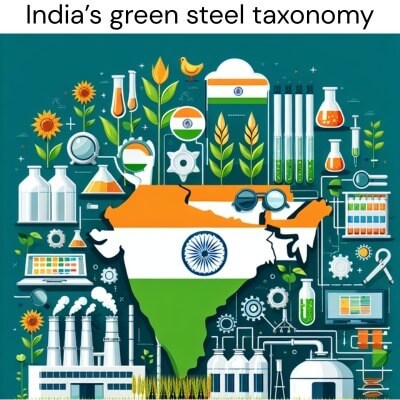
India’s Green Steel Taxonomy is a framework being developed to classify and define what constitutes "green" or low-carbon steel in the Indian context. This taxonomy is crucial as India pushes toward decarbonizing its steel sector—a major contributor to greenhouse gas (GHG) emissions—while aligning with national climate goals like net-zero by 2070.
As the world’s second-largest steel producer, India’s adoption of a Green Steel Taxonomy—set against the backdrop of evolving global regulations such as the Corporate Sustainability Reporting Directive (CSRD) and the Carbon Border Adjustment Mechanism (CBAM)—underscores the nation’s commitment to sustainable growth and maintaining global competitiveness.
India is taking a critical leap forward in aligning its steel sector with global climate and trade imperatives through the creation of a Green Steel Taxonomy. More than just a classification framework, this taxonomy is poised to become the defining standard for sustainable steel production in India—ensuring credibility, accountability, and alignment with both national and international objectives.
At the heart of any green taxonomy lies a quantitative definition of sustainability. India’s Green Steel Taxonomy will establish CO₂ emission thresholds (e.g., kg CO₂ per ton of crude steel), specific to different production routes:
The foundational metric of the taxonomy is CO₂-equivalent emission intensity per ton of finished steel (t-CO₂ e/tfs). A plant must maintain an emission intensity below 2.2 t- CO₂ e/tfs to be eligible for a green rating.
A standardized star system classifies green steel based on emission levels:
India’s taxonomy aims to be technology-neutral. Rather than prescribing a one-size-fits-all approach, it recognizes multiple production pathways:
Green steel is not only about the furnace but also the fuel. The taxonomy will prioritize:
Steel plants that demonstrate significant replacement of fossil energy with renewable sources will be favorably classified under the taxonomy, aligning with India’s target of 50% non-fossil electricity by 2030
Steel is infinitely recyclable—but the recycling rate varies greatly by region. The taxonomy will encourage:
This attribute supports:
Carbon Capture and Storage (CCUS): Enabling Transitional Compliance
For legacy BF–BOF producers, CCUS offers a viable medium-term path. The taxonomy will:
This encourages continued production while investing in long-term abatement solutions.
Lifecycle Emissions Perspective: Beyond the Factory Gates
Rather than focusing only on plant-level emissions, the taxonomy is expected to adopt a Life Cycle Assessment (LCA) lens. This means considering:
To avoid greenwashing, the taxonomy will require:
This system will be developed in collaboration with institutions like the Bureau of Energy Efficiency (BEE) and quality assurance agencies.
India’s Green Steel Taxonomy represents more than just a classification scheme—it is a transformative policy tool designed to catalyze deep decarbonization in one of the country's most emission-intensive industries. By establishing clear carbon intensity thresholds, promoting technological inclusivity, and encouraging the adoption of renewable energy and circular practices, the taxonomy provides a credible roadmap for the transition to low-carbon steel production.
This move reinforces India's commitment to its net-zero target by 2070, while also preparing domestic steelmakers for compliance with global climate-aligned trade frameworks like the Carbon Border Adjustment Mechanism (CBAM) and Corporate Sustainability Reporting Directive (CSRD). The integration of third-party verification, star-based ratings, and lifecycle thinking ensures both accountability and transparency—hallmarks of a robust green economy framework.
As the global demand for sustainable materials grows, India’s proactive step to define, regulate, and incentivize green steel not only secures its place in future supply chains but also demonstrates leadership on the world stage. The taxonomy will serve as a guiding compass for policymakers, producers, investors, and consumers alike—steering the industry toward responsible growth, environmental stewardship, and long-term economic resilience.
In essence, the Green Steel Taxonomy is not just about measuring carbon—it’s about measuring progress toward a sustainable future.
For more details, please visit Metacorp ESG Services





We are the pioneers in offering environmental consulting services to our patrons, giving us the first mover advantage & keeping us ahead of our competitors.
Very experienced in filing, monitoring & submission of CDSCO Compliances, Drugs Manufacturing & sale guidelines, Environmental Impact Assessment, AERB consulting services, Pollution Control Board CTE & CTO Advisory Services, Waste Management Authorization from State Pollution Control Boards, Fertilizers & Insecticides Manufacturing, Wholesale & Import Compliances
